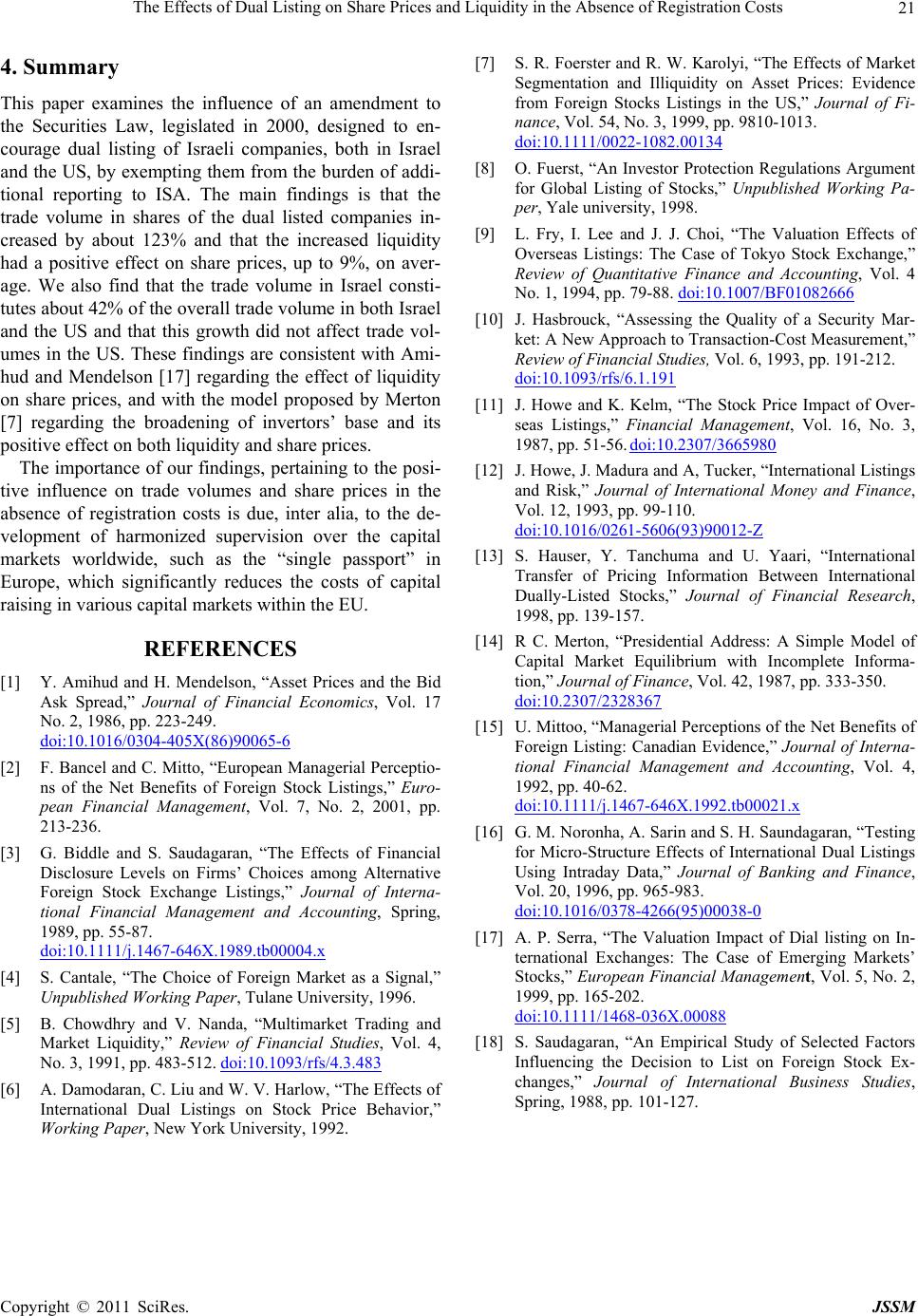
The Effects of Dual Listing on Share Prices and Liquidity in the Absence of Registration Costs 21
4. Summary
This paper examines the influence of an amendment to
the Securities Law, legislated in 2000, designed to en-
courage dual listing of Israeli companies, both in Israel
and the US, by exempting them from the burden of addi-
tional reporting to ISA. The main findings is that the
trade volume in shares of the dual listed companies in-
creased by about 123% and that the increased liquidity
had a positive effect on share prices, up to 9%, on aver-
age. We also find that the trade volume in Israel consti-
tutes about 42% of the overall trade volume in both Israel
and the US and that this growth did not affect trade vol-
umes in the US. These findings are consistent with Ami-
hud and Mendelson [17] regarding the effect of liquidity
on share prices, and with the model proposed by Merton
[7] regarding the broadening of invertors’ base and its
positive effect on both liquidity and share prices.
The importance of our findings, pertaining to the posi-
tive influence on trade volumes and share prices in the
absence of registration costs is due, inter alia, to the de-
velopment of harmonized supervision over the capital
markets worldwide, such as the “single passport” in
Europe, which significantly reduces the costs of capital
raising in various capital markets within the EU.
REFERENCES
[1] Y. Amihud and H. Mendelson, “Asset Prices and the Bid
Ask Spread,” Journal of Financial Economics, Vol. 17
No. 2, 1986, pp. 223-249.
doi:10.1016/0304-405X(86)90065-6
[2] F. Bancel and C. Mitto, “European Managerial Perceptio-
ns of the Net Benefits of Foreign Stock Listings,” Euro-
pean Financial Management, Vol. 7, No. 2, 2001, pp.
213-236.
[3] G. Biddle and S. Saudagaran, “The Effects of Financial
Disclosure Levels on Firms’ Choices among Alternative
Foreign Stock Exchange Listings,” Journal of Interna-
tional Financial Management and Accounting, Spring,
1989, pp. 55-87.
doi:10.1111/j.1467-646X.1989.tb00004.x
[4] S. Cantale, “The Choice of Foreign Market as a Signal,”
Unpublished Working Paper, Tulane University, 1996.
[5] B. Chowdhry and V. Nanda, “Multimarket Trading and
Market Liquidity,” Review of Financial Studies, Vol. 4,
No. 3, 1991, pp. 483-512. doi:10.1093/rfs/4.3.483
[6] A. Damodaran, C. Liu and W. V. Harlow, “The Effects of
International Dual Listings on Stock Price Behavior,”
Working Paper, New York University, 1992.
[7] S. R. Foerster and R. W. Karolyi, “The Effects of Market
Segmentation and Illiquidity on Asset Prices: Evidence
from Foreign Stocks Listings in the US,” Journal of Fi-
nance, Vol. 54, No. 3, 1999, pp. 9810-1013.
doi:10.1111/0022-1082.00134
[8] O. Fuerst, “An Investor Protection Regulations Argument
for Global Listing of Stocks,” Unpublished Working Pa-
per, Yale university, 1998.
[9] L. Fry, I. Lee and J. J. Choi, “The Valuation Effects of
Overseas Listings: The Case of Tokyo Stock Exchange,”
Review of Quantitative Finance and Accounting, Vol. 4
No. 1, 1994, pp. 79-88. doi:10.1007/BF01082666
[10] J. Hasbrouck, “Assessing the Quality of a Security Mar-
ket: A New Approach to Transaction-Cost Measurement,”
Review of Financial Studies, Vol. 6, 1993, pp. 191-212.
doi:10.1093/rfs/6.1.191
[11] J. Howe and K. Kelm, “The Stock Price Impact of Over-
seas Listings,” Financial Management, Vol. 16, No. 3,
1987, pp. 51-56. doi:10.2307/3665980
[12] J. Howe, J. Madura and A, Tucker, “International Listings
and Risk,” Journal of International Money and Finance,
Vol. 12, 1993, pp. 99-110.
doi:10.1016/0261-5606(93)90012-Z
[13] S. Hauser, Y. Tanchuma and U. Yaari, “International
Transfer of Pricing Information Between International
Dually-Listed Stocks,” Journal of Financial Research,
1998, pp. 139-157.
[14] R C. Merton, “Presidential Address: A Simple Model of
Capital Market Equilibrium with Incomplete Informa-
tion,” Journal of Finance, Vol. 42, 1987, pp. 333-350.
doi:10.2307/2328367
[15] U. Mittoo, “Managerial Perceptions of the Net Benefits of
Foreign Listing: Canadian Evidence,” Journal of Interna-
tional Financial Management and Accounting, Vol. 4,
1992, pp. 40-62.
doi:10.1111/j.1467-646X.1992.tb00021.x
[16] G. M. Noronha, A. Sarin and S. H. Saundagaran, “Testing
for Micro-Structure Effects of International Dual Listings
Using Intraday Data,” Journal of Banking and Finance,
Vol. 20, 1996, pp. 965-983.
doi:10.1016/0378-4266(95)00038-0
[17] A. P. Serra, “The Valuation Impact of Dial listing on In-
ternational Exchanges: The Case of Emerging Markets’
Stocks,” European Financial Management, Vol. 5, No. 2,
1999, pp. 165-202.
doi:10.1111/1468-036X.00088
[18] S. Saudagaran, “An Empirical Study of Selected Factors
Influencing the Decision to List on Foreign Stock Ex-
changes,” Journal of International Business Studies,
Spring, 1988, pp. 101-127.
Copyright © 2011 SciRes. JSSM